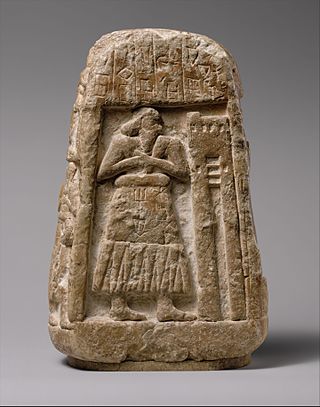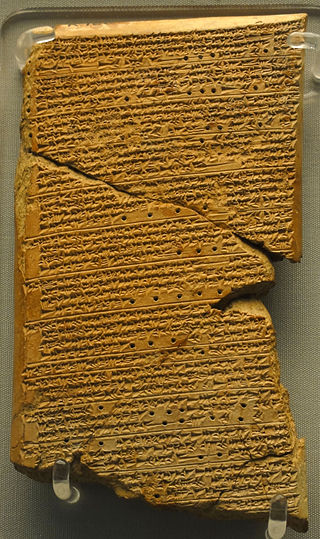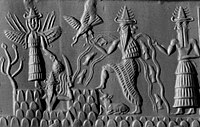
Ninḫursaĝ sometimes transcribed Ninursag, Ninḫarsag, or Ninḫursaĝa, also known as Damgalnuna or Ninmah, was the ancient Sumerian mother goddess of the mountains, and one of the seven great deities of Sumer. She is known earliest as a nurturing or fertility goddess. Temple hymn sources identify her as the "true and great lady of heaven" and kings of Lagash were "nourished by Ninhursag's milk". She is the tutelary deity to several Sumerian leaders.

Inanna is an ancient Mesopotamian goddess of love, war, and fertility. She is also associated with beauty, sex, divine law, and political power. She was known by the Akkadian Empire, Babylonians, and Assyrians as Ishtar. Her primary title was "the Queen of Heaven", and she was the patron goddess of the Eanna temple at the city of Uruk, which was her early main cult center. In archaic Uruk she was worshiped in three forms, morning Inanna (Inana-UD/hud), evening Inanna and princely Inanna, the former two reflecting the phases of the planet Venus which she was associated with. Her most prominent symbols included the lion and the eight-pointed star. Her husband was the god Dumuzid, and her sukkal, or personal attendant, was the goddess Ninshubur, who later became conflated with the male deities Ilabrat and Papsukkal.

Shamash was the ancient Mesopotamian sun god, earlier known as Utu. He was believed to see everything that happened in the world every day, and was therefore responsible for justice and protection of travelers. As a divine judge, he could be associated with the underworld. Additionally, he could serve as the god of divination, typically alongside the weather god Adad. While he was universally regarded as one of the primary gods, he was particularly venerated in Sippar and Larsa.The moon god Nanna (Sin) and his wife Ningal were regarded as his parents, while his twin sister was Inanna (Ishtar). Occasionally other goddesses, such as Manzat and Pinikir, could be regarded as his sisters too. The dawn goddess Aya (Sherida) was his wife, and multiple texts describe their daily reunions taking place on a mountain where the sun was believed to set. Among their children were Kittum, the personification of truth, dream deities such as Mamu, as well as the god Ishum. Utu's name could be used to write the names of many foreign solar deities logographically. The connection between him and the Hurrian solar god Shimige is particularly well attested, and the latter could be associated with Aya as well.

Ningal was a Mesopotamian goddess regarded as the wife of the moon god, Nanna/Sin. She was particularly closely associated with his main cult centers, Ur and Harran, but they were also worshiped together in other cities of Mesopotamia. She was particularly venerated by the Third Dynasty of Ur and later by kings of Larsa.

Ninsun was a Mesopotamian goddess. She is best known as the mother of the hero Gilgamesh and wife of deified legendary king Lugalbanda, and appears in this role in most versions of the Epic of Gilgamesh. She was associated with Uruk, where she lives in this composition, but she was also worshiped in other cities of ancient Mesopotamia, such as Nippur and Ur, and her main cult center was the settlement KI.KALki.
Ninkasi was the Mesopotamian goddess of beer and brewing. It is possible that in the first millennium BC she was known under the variant name Kurunnītu, derived from a term referring to a type of high quality beer. She was associated with both positive and negative consequences of the consumption of beer. In god lists, such as the An = Anum list and the Weidner god list, she usually appears among the courtiers of the god Enlil, alongside deities such as Ninimma and Ninmada. She could also be paired with Siraš, a goddess of similar character, who sometimes was regarded as her sister. A possible association between her and the underworld deities Nungal and Laṣ is also attested, possibly in reference to the possible negative effects of alcohol consumption.

Nanshe was a Mesopotamian goddess in various contexts associated with the sea, marshlands, the animals inhabiting these biomes, namely bird and fish, as well as divination, dream interpretation, justice, social welfare, and certain administrative tasks. She was regarded as a daughter of Enki and sister of Ningirsu, while her husband was Nindara, who is otherwise little known. Other deities who belonged to her circle included her daughter Nin-MAR.KI, as well as Hendursaga, Dumuzi-abzu and Shul-utula. In Ur she was incorporated into the circle of Ningal, while in incantations she appears alongside Ningirima or Nammu.

Nanaya was a Mesopotamian goddess of love, closely associated with Inanna.

Ningishzida was a Mesopotamian deity of vegetation, the underworld and sometimes war. He was commonly associated with snakes. Like Dumuzi, he was believed to spend a part of the year in the land of the dead. He also shared many of his functions with his father Ninazu.

Ninshubur, also spelled Ninšubura, was a Mesopotamian goddess whose primary role was that of the sukkal of the goddess Inanna. While it is agreed that in this context Ninshubur was regarded as female, in other cases the deity was considered male, possibly due to syncretism with other divine messengers, such as Ilabrat. No certain information about her genealogy is present in any known sources, and she was typically regarded as unmarried. As a sukkal, she functioned both as a messenger deity and as an intercessor between other members of the pantheon and human petitioners.
Ningirida was a Mesopotamian goddess regarded as the wife of Ninazu and mother of Ningishzida. Little is known about her character beyond her relation to these two gods.
Azimua, also known as Ninazimua, was a Mesopotamian goddess regarded as the wife of Ningishzida.
Belet-Seri was a Mesopotamian goddess who served as a scribe in the court of the underworld goddess Ereshkigal. She could be regarded as the Akkadian counterpart of Sumerian Geshtinanna, but the name could also function as a title of Ašratum, the wife of Amurru, or as a fully independent deity.

Shara was a Mesopotamian god associated with the city of Umma and other nearby settlements. He was chiefly regarded as the tutelary deity of this area, responsible for agriculture, animal husbandry and irrigation, but he could also be characterized as a divine warrior. In the third millennium BCE his wife was Ninura, associated with the same area, but later, in the Old Babylonian period, her cult faded into obscurity and Shara was instead associated with Usaḫara or Kumulmul. An association between him and Inanna is well attested. In Umma, he was regarded as the son of Inanna of Zabalam and an unknown father, while in the myth Inanna's Descent to the Underworld he is one of the servants mourning her temporary death. He also appears in the myth of Anzû, in which he is one of the three gods who refuse to fight the eponymous monster.

Nungal, also known as Manungal and possibly Bēlet-balāṭi, was the Mesopotamian goddess of prisons, sometimes also associated with the underworld. She was worshiped especially in the Ur III period in cities such as Nippur, Lagash and Ur.

Ninisina was a Mesopotamian goddess who served as the tutelary deity of the city of Isin. She was considered a healing deity. She was believed to be skilled in the medical arts, and could be described as a divine physician or midwife. As an extension of her medical role, she was also believed to be capable of expelling various demons. Her symbols included dogs, commonly associated with healing goddesses in Mesopotamia, as well as tools and garments associated with practitioners of medicine.

Ninsianna was a Mesopotamian deity considered to be the personification of Venus. This theonym also served as the name of the planet in astronomical texts until the end of the Old Babylonian period. There is evidence that Ninsianna's gender varied between locations, and both feminine and masculine forms of this deity were worshiped. Due to their shared connection to Venus, Ninsianna was associated with Inanna. Furthermore, the deity Kabta appears alongside Ninsianna in many texts, but the character of the relation between them remains uncertain.
Dumuzi-abzu, sometimes spelled Dumuziabzu, was a Mesopotamian goddess worshiped in the state of Lagash. She was the tutelary deity of Kinunir.

Annunitum or Anunītu was a Mesopotamian goddess of war. While initially she functioned as an epithet of Ishtar, she started to develop into a separate deity in the final years of the Sargonic period and through the Ur III period.
Ninmug or Ninmuga was a Mesopotamian goddess. She was associated with artisanship, especially with metalworking, as evidenced by her epithet tibira kalamma, "metalworker of the land." She could also be regarded as a goddess of birth and assistant of Ninmah, most likely because the fashioning of statues of deities and the birth of children could be described with the same terms in Sumerian texts. Her main cult centers were Kisiga, whose location remains uncertain, and Adab.















